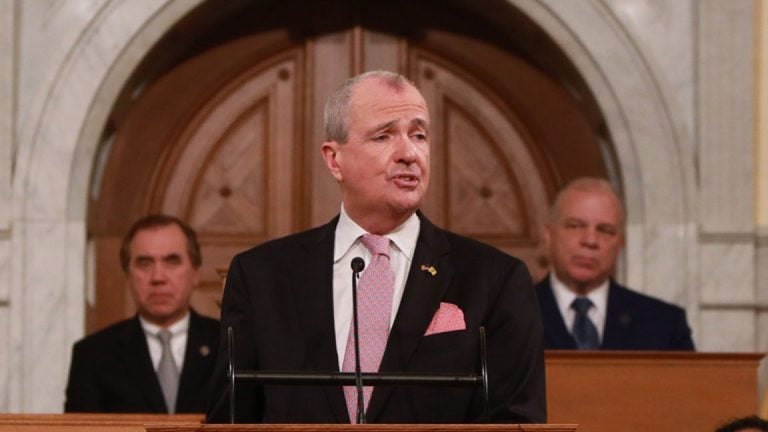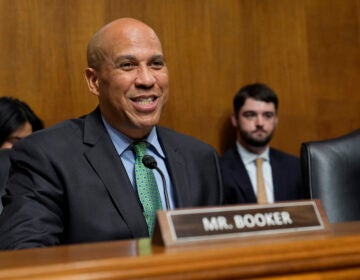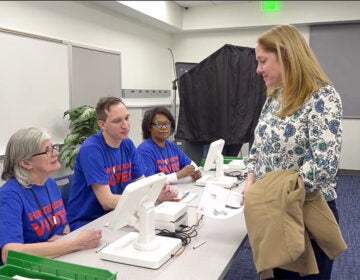Explainer: What happens to a bill when a legislative session ends
How process usually works and what changes once new lawmakers are sworn into office

Gov. Phil Murphy delivering the State of the State address. (Edwin J. Torres/Governor's Office)
This article originally appeared on NJ Spotlight.
–
New Jersey just completed its biannual changing of the State House guard, with the swearing in of the 219th Legislature and the start of a new cycle of lawmaking.
All the bills left pending in the Senate or Assembly at the end of a legislative session — the 218th ended at noon Tuesday — are tossed out, so the new session starts with essentially a clean slate. But the first week of a new session is also a kind of limbo for those bills and resolutions that passed both houses of the Legislature in the waning days of the session because the governor still gets time to consider them.
The rules for what happens to a bill at the end of a two-year session are different from the norm. Here’s how the process usually works and what changes once new lawmakers are sworn into office.
The typical process
Normally, after a bill moves through the legislative process and both the Senate and Assembly pass it, the governor has 45 days to act on it. If the house in which the bill originated is not in session on the 45th day, the governor has until that house is back in session to act on the measure. The governor can sign the bill, or use a veto to prevent it from becoming law. An absolute veto kills the bill unless two-thirds of the members of both houses of the Legislature — 27 in the Senate, 54 in the Assembly — vote to override that veto. In a conditional veto, the governor suggests amendments, and lawmakers can try to override the veto or agree to the conditions by a simple majority and send the bill back to the governor for his signature. The line-item veto is used almost exclusively on the budget and allows the governor to delete specific spending items.
If he takes no action, the bill becomes law, although this rarely is the case, because the governor typically wants to have the ultimate say in approving or nixing a bill. Only once in the last two dozen years has a governor allowed a bill to become law without his signature: Former Gov. Jon Corzine permitted to become law a bill exempting certain manufacturing facilities from paying some taxes and energy charges for seven years.
As of Wednesday, Gov. Phil Murphy had signed 521 laws and another 39 joint resolutions sponsored by the 218th Legislature. He signed dozens of them, and issued several vetoes and conditional vetoes, on Monday, which cleared his desk of all measures he had received through the end of 2019.
The last 10 days of the session
The rules change for bills sent by the Legislature to the governor during the last 10 days of the session, which this year meant anything passed from Jan. 4 through Monday, although as a practical matter, voting sessions only took place on Jan. 9 — in the Senate only — and Monday. According to the nonpartisan Office of Legislative Services’ database, lawmakers or the governor took action on 555 measures on those two days and the houses sent Murphy 201 bills and eight joint resolutions.
The governor has seven days after the end of the session to sign into law any of the measures sent to him during the last 10 days of the session. This year, that gives Murphy until noon next Tuesday to act on a bill or it dies, like the close to 11,000 measures that were still pending at the end of the last session did at noon on Jan. 14 when that session ended.
Murphy already has signed two measures, both of which he said he supported during his State of the State address Tuesday. One of those (A-3087) expands the definition of terrorism. The other (A-6123) makes an additional $1 million available to nonprofits for security measures.
A conditional veto or absolute veto that lawmakers could try to override can only be issued through the end of the session on those bills the governor receives in the last 10 days. Once the session ends, the governor gets the last word. All those bills he does not sign are vetoed automatically in what is called a pocket veto. The week after a legislative session is the only time these automatic pocket vetoes occur.
Past governors have treated these bills differently, depending on the composition of the Legislature and their relationships with lawmakers. Former Gov. Chris Christie, a Republican who had a Democratic Legislature for all eight years he was in office, pocket vetoed between 42 and 62 bills per session. Corzine and former Govs. Dick Codey and Jim McGreevey, all Democrats with either Democratic or split Legislatures, pocket vetoed fewer than five per session.
It is unclear what Murphy may do with the 207 measures remaining on his desk, but he has a rocky relationship with some legislative leaders — Senate President Steve Sweeney (D-Gloucester), in particular — and has vetoed or conditionally vetoed a greater percentage of bills sent to him than any of his three Democratic predecessors.
Murphy is likely to support many. Among the bills on his desk are ones that would boost electric vehicle charging, appropriate dedicated funds for open space and other conservation purposes, and boost apprenticeship programs. But lawmakers have also sent him some bills seeking supplemental appropriations for special projects, and Murphy has not been as open to these — vetoing one of those Monday.
It’s not necessarily over
Neither a pocket veto at the end of the session, nor the expiration of bills that did not make it all the way through the legislative process, is necessarily the end of a piece of legislation. Those lawmakers who remain from the previous legislative session and 112 members, or 94% of the Legislature’s members, are free to try again by reintroducing legislation. According to the OLS website, 3,371 bills were introduced on the first day of the new session, with the vast majority of them leftovers that were prefiled.
WHYY is your source for fact-based, in-depth journalism and information. As a nonprofit organization, we rely on financial support from readers like you. Please give today.




